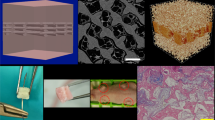Abstract
Cartilage and meniscal lesions have limited potential for spontaneous repair. Consequently, much effort has been made to develop methods for repairing such lesions. Double-network (DN) gels are new candidate-materials for repairing such lesions. They exhibit exceptional mechanical strength and toughness in spite of their high water content. In this study, we prepared highly tough DN hydrogels and investigated the mechanical properties related to clinical implant use. The mechanical properties such as Young’s modulus and suture tear-out strength were measured for the artificial replacement. The results suggest that the suture property of DN hydrogels can be adjusted by controlling the crosslinking density and monomer concentration. Finite element method was also applied to these DN hydrogels in order to check whether the fracture strength of the material is enough to meet a medical purpose.
Similar content being viewed by others
References
Arnold, M.P., A.U. Daniels, S. Ronken, H.A. Garcia, N.F. Friederich, T. Kurokawa, J.P. Gong, and D. Wirz, 2011, Acrylamide polymer double-network hydrogels: candidate cartilage repair materials with cartilage-like dynamic stiffness and attractive surgery-related attachment mechanics, Cartilage 2, 374–383.
Chen, G. and A.S. Hoffman, 1995, Graft copolymers that exhibit temperature-induced phase transitions over a wide range of pH, Nature 373, 49–52.
Chen, Q. and R.H. Colby, 2014, Linear viscoelasticity of sulfonated styrene oligomers near the sol-gel transition, Korea-Aust. Rheol. J. 26, 257–261.
Diehl, T., 2008, On using a penalty-based cohesive-zone finite element approach, part I: elastic solution benchmarks, Int. J. Adhes. Adhes. 28, 237–255.
Drury, J.L. and D.J. Mooney, 2003, Hydrogels for tissue engineering: scaffold design variables and applications, Biomaterials 24, 4337–4351.
Garcia, H.A., A.U. Daniels, and D. Wirz, 2008, Dual-mode dynamic functional stiffness of articular cartilage, Eur. Cells Mater. 16, 7.
Gong, J.P., 2010, Why are double network hydrogels so tough?, Soft Matter 6, 2583–2590.
Gong, J.P., T. Kurokawa, T. Narita, G. Kagata, Y. Osada, G. Nishimura, and M. Kinjo, 2001, Synthesis of hydrogels with extremely low surface friction, J. Am. Chem. Soc. 123, 5582–5583.
Gong, J.P., Y. Katsuyama, T. Kurokawa, and Y. Osada, 2003, Double-network hydrogels with extremely high mechanical strength, Adv. Mater. 15, 1155–1158.
Farhadi, J., I. Fulco, S. Miot, D. Wirz, M. Haug, and S. C. Dickinson, 2006, Precultivation of engineered human nasal cartilage enhances the mechanical properties relevant for use in facial reconstructive surgery, Ann. Surg. 244, 978–985.
Langer, R. and D.A. Tirrell, 2004, Designing materials for biology and medicine, Nature 428, 487–492.
Na, Y.H., 2013, Double network hydrogels with extremely high toughness and their applications, Korea-Aust. Rheol. J. 25, 185–196.
Na, Y.-H., T. Kurokawa, Y. Katsuyama, H. Tsukeshiba, J.P. Gong, Y. Osada, S. Okabe, T. Karino, and M. Shibayama, 2004, Structural characteristics of double network gels with extremely high mechanical strength, Macromolecules 37, 5370–5374.
Na, Y.-H., Y. Tanaka, Y. Kawauchi, H. Furukawa, T. Sumiyoshi, J.P. Gong, and Y. Osada, 2006, Necking phenomenon of double-network gels, Macromolecules 39, 4641–4645.
Nair, A.U., L. Hubert, and A.M. Bestelmeyer, 2009, Characterization of damage in hyperelastic materials using standard test methods and abaqus, 2009 SIMULIA Customer Conference, 1–15.
Osada, Y., H. Okuzaki, and H. Hori, 1992, A polymer gel with electrically driven motility, Nature 355, 242–244.
Tanaka, Y., I. Nishio, S.T. Sun, and S. Ueno-Nishio, 1982, Collapse of gels in an electric-field, Science 218, 467–469.
Tsukeshiba, H., M. Huang, Y.-H. Na, T. Kurokawa, R. Kuwabara, Y. Tanaka, H. Furukawa, Y. Osada, and J.P. Gong, 2005, Effect of polymer entanglement on the toughening of double network hydrogels, J. Phys. Chem. B 109, 16304–16309.
Wirz, D., K. Kohelr, B. Keller, D. Gopfert, D. Hudetz, and A.U. Daniels, 2008, Dynamic stiffness of articular cartilage by single impact microindentation (SIMI), J. Biomech. 41, S172.
Yoshida, R., T. Takahashi, T. Yamaguchi, and H. Ichijo, 1997, Self-oscillating gels, Adv. Mater. 9, 175–178.
Author information
Authors and Affiliations
Corresponding author
Rights and permissions
About this article
Cite this article
Na, Y.H., Oh, H.Y., Ahn, Y.J. et al. Suturing property of tough double network hydrogels for bio-repair materials. Korea-Aust. Rheol. J. 27, 25–31 (2015). https://doi.org/10.1007/s13367-015-0004-1
Received:
Revised:
Accepted:
Published:
Issue Date:
DOI: https://doi.org/10.1007/s13367-015-0004-1




